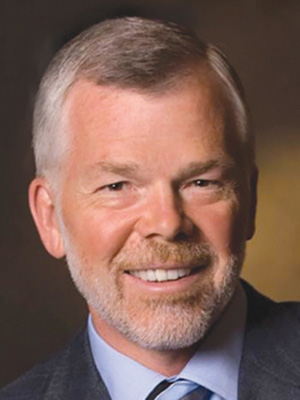Health care leaders, lawmakers, educators, and individuals must come together to tackle mental health workforce shortages.
Recent recommendations by the California Future Health Workforce Commission provide a model for the nation as we look to recruit, train, and retain more mental health professionals who reflect the diversity of the populations we serve.
For the past 2 years, I’ve been honored to serve on the California Future Health Workforce Commission. The Commission assembled nearly two dozen experts from the health, education, and labor sectors tasked to craft a workable plan aimed at assuring we have the right health workforce to support California’s growing and remarkably diverse population.
To accomplish this goal, we opted early on to focus on primary care, the needs of the senior population, and mental health as key opportunities to impact the health of our residents and communities. For over a year, I participated in the deliberations of the Commission’s Behavioral Health Subcommittee as we looked at how to overcome the significant mismatch between the demand for mental health services and the available supply of mental health professionals.
- According to the Commission’s findings, nearly 17% of Californians today have mental health needs, and 1 in 20 has a serious mental health condition. Among these, approximately two-thirds of adults with a mental illness and two-thirds of adolescents with major depressive episodes do not receive the treatment they need.
- Without significant changes to the system, the situation in California will only get worse. The Commission projects that California will have 41% fewer psychiatrists and 11% fewer psychologists, marriage and family therapists, clinical counselors and social workers than needed by 2030.
- Gaps in care are particularly acute for millions of Californians already living in communities facing overall shortages of health professionals, including both rural and underserved urban areas.
Key recommendations for California’s mental health workforce
To address these needs, the Commission released its final report, Meeting the Demand for Health, in February 2019. The report includes 27 recommendations that the Commission believes are critical to implement over the next decade, and spotlights 10 priority actions as the most urgent first steps toward building the health workforce California will need.
I recently participated in a policy briefing in Los Angeles to support the rollout of the report focused on its recommendations for mental health. I would like to share a few of those recommendations today in the hopes of building and supporting consensus around these recommendations and advancing this important agenda.
Create a better pipeline: The Commission includes 2 priority recommendations to build a better pipeline of mental health professionals. These include expanding the number of psychiatric residency positions to add 2,202 psychiatrists by 2030. The Commission also recommends developing a psychiatric nurse practitioner program that recruits from and trains providers to work in underserved communities, adding 300 mental health nurse practitioners over 5 years. An important part of this effort will be to reduce the debt of medical students and graduate students in mental health professions to provide greater economic freedom to practice in communities where pay may be less than other areas.
Leverage the existing workforce: At the same time, we must elevate solutions that leverage the existing workforce. With the anticipated scarcity of providers over the next decade, providers of mental health care and other services in support of patient care need to practice at the top of their license. It will also be critical to engage non-traditional supports, such as peer specialists, community health workers, and community organizations. (This recommendation was explored in a fascinating panel at a recent forum hosted by Kaiser Permanente’s Institute for Health Policy). In fact, the Commission recommendations explicitly call for the state to scale the engagement of community health workers, promotores, and peer providers through certification, training, and reimbursement to increase the supply of workers focused on prevention and behavioral health.
Bundle mental health services with primary care: The briefing recognized the clear benefit in having mental health professionals in the primary care setting. Many behavioral health conditions present in primary care and research tells us that many times the mental health needs of these patients are either unrecognized or undertreated. Bringing primary care and mental health together bridges that gap, evidence shows. One opportunity to accelerate the bundling of primary care and mental health services is to promote and expand programs such as the University of California, Davis program in psychiatry and medicine. This program offers a strong model aimed at developing physicians with more knowledge in caring for behavioral health conditions in primary care.
Integrate technology: Technology is critically important to the effort to provide high-quality health care throughout the state. Telehealth can play an important role in extending our ability to reach out to rural areas who lack mental health providers, ensuring that people can more quickly and conveniently receive the care they need. In addition, access barriers exist in our urban centers and telehealth is a promising approach to solving that problem. We must always remember, it is important to proceed with thoughtfulness and rigor, placing the patient at the center of all telehealth initiatives and prioritizing those approaches that are high-tech, high-touch, and supported by evidence.
Addressing mental health workforce challenges at Kaiser Permanente
There is no simple solution to the mental health workforce challenge, and we face this complex issue directly at Kaiser Permanente. We have recognized this for some time and, despite the shortage of available mental health providers, have increased the number of therapists on staff by 30% since 2015. We are also working to use analytics to better predict when patients with depression or other mental health issues might need targeted services and support as part of our deep commitment to a proactive model for assuring quality mental health care for our members.
We are not just recruiting mental health professionals. We are working to address mental health workforce shortage through training programs at our medical centers for postdoctoral residents and post-master’s fellows. The ACGME (Accreditation Council for Graduate Medical Education) has accredited 2 new Kaiser Permanente adult psychiatry residency programs in the East Bay and San Jose medical centers, starting in 2019.
We’re also dedicated to training physicians who personally and professionally understand mental health’s impact on overall health. The Kaiser Permanente School of Medicine will welcome its first class in Pasadena in the summer of 2020. The school is paying attention to student wellness and, as part of the curriculum, will be teaching students about strategies to help them become resilient practitioners and prepare them for the challenges they will encounter while in medical school and in the field of medicine. These individuals will learn what it takes to maintain their own overall physical and mental health, and by extension what it will take for their patients.
Kaiser Permanente has provided the School of Medicine with funding for full tuition for our first five classes. The school is also providing substantial financial aid to help students cover living expenses. These funds, which will come from the community benefit spending that Kaiser Permanente provides each year, will reduce the burden of debt so students have greater freedom to choose which field they enter or where they choose to practice. The objective is to train physicians dedicated to, prepared for, and facing fewer financial barriers to working with underserved communities.
Now is the time to act
While the time horizon for the Commission’s recommendations is 10 years, the time for action is now. We must work together today to explore safe, high-quality ways to extend and expand flexibility of practice scope, as well as take full advantage of the skilled professionals we already have in primary care and other settings. Everyone has a role to play in letting decision makers know it is a priority to care for the mental and total health needs of Americans. Together, we can march in lockstep towards one simple goal: more people get the care they need, and more people enjoy total health in mind, body, and spirit.

